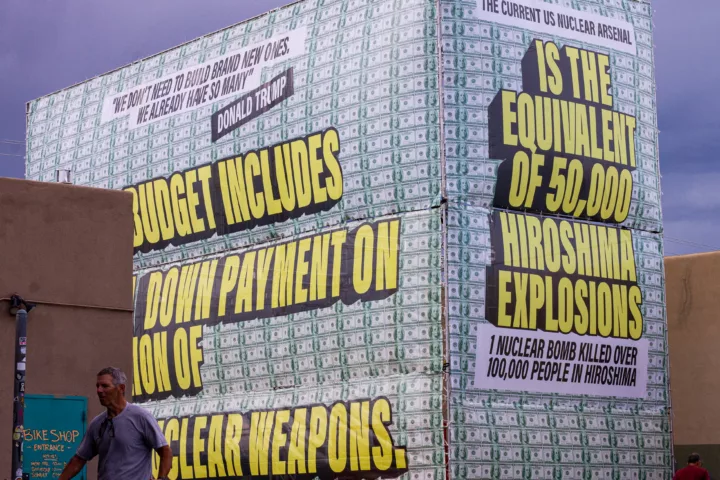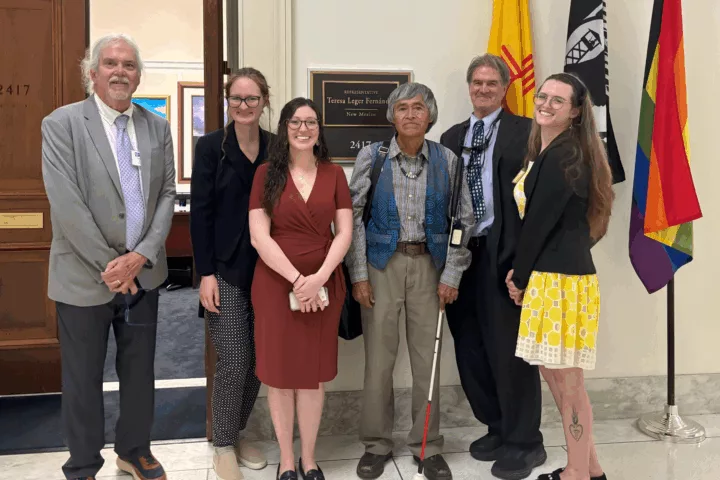According to media reports, Andrea Romero, Executive Director of the Regional Coalition of LANL Communities, is accused of charging some $2,200 dollars of unallowable travel costs, such as alcohol and baseball tickets, while lobbying in Washington, DC for additional funding for the Los Alamos National Laboratory (LANL). She in turn accused the nonprofit group Northern New Mexico Protects of political motivations in revealing these questionable expenses. Romero is running in the Democrat Party primary against incumbent state Rep. Carl Trujillo for Santa Fe County’s 46th district in the state House of Representatives.
Perhaps more serious is the fact that Romero was awarded an undisclosed amount of money by the Venture Acceleration Fund (VAF) for her private business Tall Foods, Tall Goods, a commercial ostrich farm in Ribera, NM. According to a May 8, 2017 Los Alamos Lab news release announcing the award to Tall Foods, Tall Goods, “The VAF was established in 2006 by Los Alamos National Security [LANS], LLC to stimulate the economy by supporting growth-oriented companies.”[1] LANS, primarily composed of the Bechtel Corporation and the University of California, has held the annual ~$2.4 billion Los Alamos National Laboratory (LANL) management contract since June 2006.
The Regional Development Corporation administers the Venture Acceleration Fund.[2] It states that the median VAF award in 2017 was $41,000, and that preference is given to companies that “Have an association with LANL Technology or Expertise.” [3]
It is, at a minimum, unseemly for the Executive Director of the Regional Coalition, which lobbies for increased LANL funding, to receive funding for her private business from LANS, who runs LANL.[4] Ultimately that funding for her private business comes from the American taxpayer.
Romero’s employer, the Regional Coalition, is overwhelmingly funded by the Department of Energy (DOE) and the Los Alamos County government, which receives more than $30 million dollars annually from the Lab through state gross receipts taxes. The Regional Coalition has been lobbying the New Mexico legislature to pass a state law requiring that LANL continue to pay gross receipts tax in the event that its management contract is taken over by a nonprofit university.[5] If successful, that would help to ensure the Regional Coalition’s funding stream.
Concerning the “adequate funding for LANL” that the Regional Coalition lobbies for, LANL’s annual ~$2.4 billion budget is now 70% for core nuclear weapons research and production programs, while much of its remaining funding either directly or indirectly supports those programs. In partial contradiction, the Cities and Counties of Santa Fe and Taos, which belong to the RCLC, have at various times passed resolutions against expanded plutonium pit production for nuclear weapons and/or called for genuine comprehensive cleanup at the Lab.
Despite its rhetoric on producing jobs through cleanup, the Regional Coalition has yet to take a position advocating for genuine comprehensive cleanup at LANL. Instead, the Coalition seems to condone DOE and LANL plans to “cap and cover” and leave ~150,000 cubic meters of radioactive and toxic wastes permanently buried in unlined pits and trenches at the Lab’s largest waste dump, Area G.[6] This will create a permanent nuclear waste dump above the regional groundwater aquifer, three miles uphill from the Rio Grande. Radioactive and toxic wastes are buried directly in the ground without liners, and migration of plutonium has been detected 200 feet below Area G’s surface.[7]
In September 2016 the Department of Energy released a 2016 Lifecycle Cost Estimate Summary[8] of proposed future cleanup at LANL, which RCLC Executive Director Romero hailed as:
The Lifecycle Baseline documentation provides our communities the necessary foundation to properly advocate on behalf of the best possible scenarios for cleaning up legacy nuclear waste at the Laboratory in the most time and cost-efficient manner. After years of requests for this document, we now have the tool that can get us to additional cleanup dollars to get the job done.[9]
However, at the beginning of the 2016 Lifecycle Cost Estimate Summary DOE declares that “An estimated 5,000 cubic meters of legacy waste remains, of which approximately 2,400 cm [cubic meters] is retrievably stored below ground”, a claim which was widely reported in New Mexican media. From there DOE estimated that it would cost $2.9 to $3.8 billion to complete so-called cleanup around 2040, which is woefully low. The DOE report omits any mention of the ~150,000 cubic meters of poorly characterized radioactive and toxic wastes at Area G, an amount 30 times larger than DOE acknowledges. As a partial result, DOE funding for cleanup at LANL remains flat at around $190 million per year, when the New Mexico Environment Department is on record that $250 million per year is needed.
Jay Coghlan, Nuclear Watch Director, commented,
New Mexicans often hear from the Department of Energy and our congressional delegation how nuclear weapons programs economically benefit us. If that’s the case, why is it that New Mexico has fallen from 37th in per capita income in 1957 to 48th in 2017? [10] Why is it that while Los Alamos County is the second richest county in the USA, Main Street Española hasn’t significantly changed for the better in the last 40 years? It’s clear that the economic benefits of the nuclear weapons industry go only to the select few, while to its shame New Mexico as a whole continues to be ranked as the second worst state for children.
# # #
[Copying URLs into browsers is recommended.]
[1] LANL’ s May 8, 2017 news release Six northern New Mexico businesses awarded funds to boost growth is available at https://web.archive.org/web/20200808202409/https://lanl.gov/discover/news-release-archive/2017/May/0518-6-nnm-business-awarded-funds.php
[2] “The RDC [Regional Development Corporation] was incorporated in 1996 to serve as the Department of Energy (DOE) Los Alamos Site “Community Reuse Organization” (CRO). As a CRO, the RDC’s mission is to diversify the economy within the north central New Mexico region. As a result, the RDC maintains a special working relationship with both the DOE and Los Alamos National Laboratory (LANL).” https://rdcnm.org/about/
[3] See https://web.archive.org/web/20190120214344/https://rdcnm.org/vaf/
[4] The mission statement of the Regional Coalition of LANL Communities is
… the Regional Coalition works in partnership to create one voice to ensure national decisions incorporate local needs and concerns. The organization’s focus is community and economic development, site employment, environmental remediation, and adequate funding for LANL. The Regional Coalition of LANL Communities is comprised of nine cities, counties and pueblos surrounding the Department of Energy’s Los Alamos National Laboratory (LANL). https://regionalcoalition.org/about
[5] Four universities are currently vying for the LANL management contract: Purdue (with corporate partner Bechtel), the University of California, the University of Texas, and Texas A&M (DOE Secretary Rick Perry’s alma mater). Corporate partners for the last three have not been disclosed.
[6] Estimated quantities of waste at Area G (in cubic yards) are from Table G3.41, MDA G Corrective Measures Evaluation, 2011, LANS, p. G-13. See excerpts at https://nukewatch.org/importantdocs/resources/Area_G_Pit_Totals_from_CME_rev3_Sept-2011.pdf
[7] Documentation of the plutonium detection 200 feet below the surface of Area G is at https://nukewatch.org/importantdocs/resources/AGCME Plate_B-3_radionuclides_subsurface.pdf
[8] The Department of Energy’s 2016 Lifecycle Cost Estimate Summary for LANL cleanup is available at https://nukewatch.org/importantdocs/resources/LBC-Summary-Aug-2016.pdf
[9] https://web.archive.org/web/20170124153124/http://www.santafenm.gov/news/detail/department_of_energy_release_important_baseline_study
[10] NM per capita income at https://web.archive.org/web/20161206084557/http://www.bea.gov:80/regional/bearfacts/pdf.cfm?


